Postnatal exercises
The following exercises and advice will help you to get back in shape after you have had your baby. The exercises are also suitable for all deliveries. Remember to start gently and progress slowly.
Pelvic floor muscle exercise
The pelvic floor is a sling of muscles between your coccyx (tailbone) and your pubic bone. Its purpose is to maintain continence, support the pelvic organs and stabilise the pelvis.
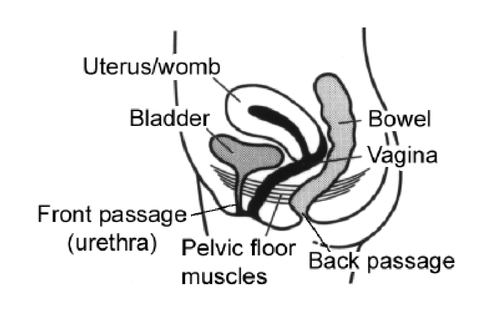
It is important to strengthen your pelvic floor muscles by exercising them. This can help with any incontinence problems you may have already or reduce your chances of developing incontinence problems in the future. Keeping the pelvic floor muscles toned can also help to prevent bladder, womb or bowel prolapse later in life.
By starting the exercises soon after the birth you can help the muscles to recover quickly. It is safe to do these exercises even if you have had stitches. Exercising the muscles will help to lessen any discomfort or swelling. We recommend starting the exercises gently the day after you have given birth. These exercises can be done in lying, sitting or standing.
Some women find it difficult to feel these muscles working at this stage. If that is the case for you, try exercising each day after the birth to check when the feeling improves.
To contract the pelvic floor muscles, imagine you are trying to stop passing wind and at the same time trying to stop the flow of urine midstream (we advise not to do your exercises while emptying your bladder) You should feel a sensation of ‘squeeze and lift’ as you close and draw up the back and front passages. Hold this for as many seconds as you can, up to a maximum of 10 seconds. At the end of the hold, there should be a definite feeling of ‘letting go’.
It is recommended that you do 24 exercises a day. Try doing 4 or 5 holds every time you feed your baby. This will help you get into the routine of doing them. We recommend that you continue to exercise the muscles daily for the rest of your life.
Detailed instructions on how to do the exercise are available in the leaflet GHPI0259 Pelvic floor exercises for women. If you have any concerns about the exercise, please contact your local Women’s Health Physiotherapy Service.
Stomach exercises
It is normal for your stomach muscles to stretch during pregnancy. This is called a divarication.
A divarication is when the tissue joining the 2 halves of your stomach muscles widens. It is important to note that your stomach muscles have not split. When the muscles have been stretched, they cannot work as well to support you, which can lead to one or more of the following symptoms
- Bulging or doming in the middle of your tummy when you sit up
- Some aches along the middle of your tummy aggravated by increased activity
- Feeling of a gap when you press into the center of your tummy - Poor posture
- Low back pain.
Start with the deep muscles as they reduce the strain on your back and pelvic floor (Stage 1). Once these exercises become easier, you can go on to working the outer muscles (Stage 2).
1st stage after delivery
Exercise 1
This first exercise works on the deepest muscle of the stomach, which acts like a corset. It stabilises the spine and pelvis, helps flatten your stomach and draws in your waistline.
Starting position
For the first few weeks, you should exercise in a comfortable position, with a pillow between your knees. You can choose to lie on your side or on your back with a pillow under your head, your knees bent and feet flat on the floor or bed.

- As you breathe out, gently draw in the lower part of your stomach, squeezing your pelvic floor muscles at the same time
- Let go slowly
Repeat this exercise 4 or 5 times, with a few seconds rest between each one.
Aim to build up slowly – contracting the muscles for no more than 10 seconds and repeat up to 10 times.
Try to keep your back still during this exercise. You should be able to breathe and talk while you do this exercise.
Exercise 2
The pelvic tilt

- Lie in the position shown and begin with the deep stomach exercise in Stage 1
- Tilt your pelvis back and flatten your back on the floor or bed
- Hold this position for a maximum of 10 seconds
Exercise 3
The Head Lift
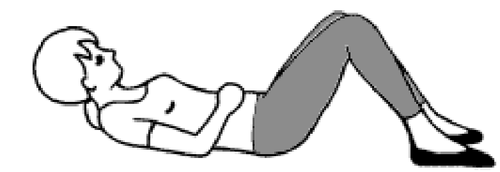
- Lie as in the position above
- Lift your head only
- Hold for a few seconds • Release gently
- Rest for a few seconds
Remember
- To practice your pelvic floor daily
- Do not allow your stomach to bulge while you exercise
2nd stage after delivery
When you feel ready, please progress to stage 2. It may take several weeks before you get to this stage; this is nothing to worry about.
Exercise 1
Glute Bridge

- Lie flat on your back, with your knees bent.
- Squeeze your bottom muscles and lift your body upwards.
- Keep your arms by your side and use them to help you balance.
Exercise 2
Squat

- Open your legs slightly wider than shoulder width.
- bend your knees to the full squat (90-degrees) position
- Try not to let your knees turn inwards
- Always keep your feet flat on the ground.
Exercise 3
Lunges
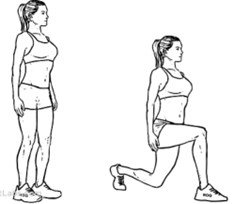
- Take a step forwards, and bend the front knee
- The back knee drops towards the floor.
- Try not to let your knee drop inwards. Only go as far as feels comfortable.
Please ensure if you have any pain, bulging of the abdominals, incontinence or heaviness in the vagina, please stop and speak to your healthcare professional
Caring for your back
As well as strengthening your stomach muscles, here are some other ways to reduce the risk of getting aches and pains in your back, as you care for your new baby.
- When changing your baby, try to make sure your baby is on a surface at waist height. If it is not, it is best to kneel down, keeping your back as straight as possible
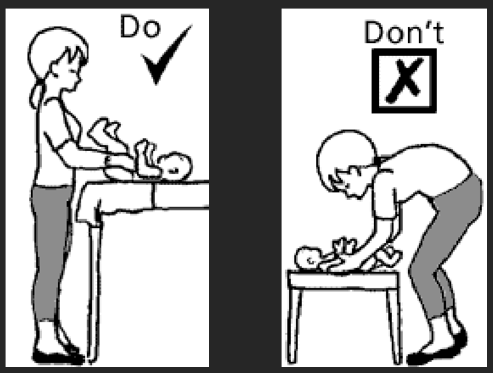
- When feeding your baby, sit on a hard but comfortable chair. Make sure your back is well supported. Placing a small, rolled towel behind your lower back helps. Make sure that your feet are supported and flat on the floor
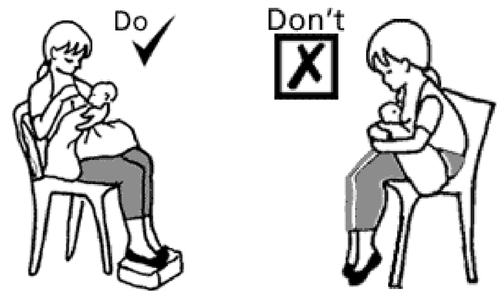
- Carry your baby in front of you; avoid carrying your baby on one hip
- Bend your knees and keep your back straight when lifting
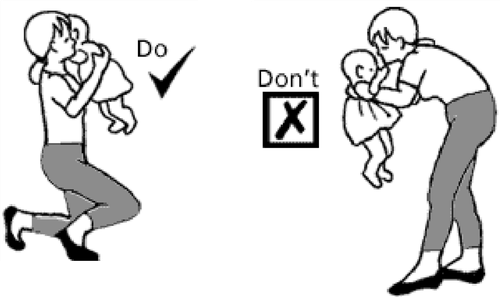
- Kneel at the bath side rather than leaning over
- Lower the cot side when lifting or lowering your baby
- Keep your baby close to you when moving them in and out of a car seat
If you have to carry your baby in the car seat hold it in front of you, not on your hip, or put it on a wheeled frame/buggy.
Restarting normal exercise
Top tips
- Push the pram or buggy briskly. Remember to keep your back straight. Walking is good exercise, so try and get out as much as you can
- You can try swimming when your postnatal bleeding (lochia) has stopped, any abdominal wound has healed and any pelvic pain has settled
- Join a postnatal exercise class. Many postnatal exercise classes let you exercise with your baby
- Before restarting or beginning exercise at the gym please discuss with a member of the gym team or a personal trainer
- Wait for 3 months before starting more strenuous aerobic or high impact exercise
Contact information
Physiotherapy Department
Tel: 0300 422 8527
If you carry out the pelvic floor and stomach exercises regularly you should return to normal function over time. If you have any ongoing problems, you should ask for advice from a pelvic health physiotherapist.
To see a Physiotherapist, you can self-refer online by using the link below. https://web.glos.nhs.uk/PhysiotherapySelfReferral/
Further information
To find out more information, please use the link below:
Pelvic Obstetric and Gynecological Physiotherapy (POGP)
Website:
https://thepogp.co.uk/patient_information/pregnancy_and_early_postnatal.aspx